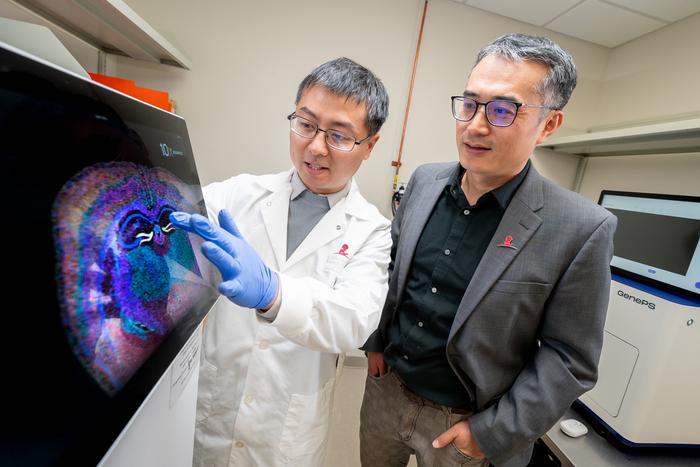Recent advancements in biomedical research have seen the emergence of spatial transcriptomics as a transformative technique, providing scientists unprecedented insight into gene expression within tissue sections. This method enables a deeper understanding of the spatial organization of cells, which is crucial for comprehending both normal biological processes and various pathologies. Until recently, researchers faced a critical dilemma: they could either achieve comprehensive genome-wide coverage or maintain the high resolution offered by single-cell analyses. However, a groundbreaking computational tool developed by scientists at St. Jude Children’s Research Hospital and the University of Wisconsin-Madison has now elegantly bridged this gap.
The newly developed tool, named Spot imager with pseudo single-cell resolution histology (Spotiphy), utilizes generative artificial intelligence to enhance the resolution of sequencing-based spatial transcriptomics without sacrificing gene coverage. This innovative algorithm represents a significant advancement in the field, allowing for a more detailed and accurate representation of gene expression in various tissues. The findings, published in the prestigious journal Nature Methods, signal a remarkable shift in how researchers can approach spatial transcriptomics.
Co-senior author Jiyang Yu, PhD, who spearheaded the research at St. Jude, emphasized the tool’s significance by stating, “We’ve made the first generative algorithm that can predict spatial gene expression of whole transcriptomics at the single-cell level.” This statement points to the algorithm’s unique capability to integrate data from both single-cell RNA sequencing and histological imaging. By leveraging generative modeling techniques, Spotiphy can provide a complete transcriptome coverage while simultaneously offering insights at the single-cell resolution.
Traditionally, spatial transcriptomics has relied on analyzing fixed “spots” on a grid, where each spot can encompass multiple cells and diverse cellular populations. This poses challenges in pinpointing precise gene expression profiles, particularly in heterogeneous tissues. Spotiphy tackles this limitation head-on, employing a machine learning framework capable of extrapolating cell-type proportions and gene expression data to effectively interpolate the spaces between these predefined spots.
To illustrate this process, Junmin Peng, another co-senior author involved in the study, provided a compelling analogy. He suggested envisioning a photograph missing a central section—by employing the learned rules from its training, Spotiphy reconstructs the absent details, effectively filling in the gaps in spatial data. This crucial advancement ensures that researchers can visualize cellular landscapes with enhanced clarity and resolution, leading to more accurate scientific conclusions.
One of the notable applications of Spotiphy has been in the study of neurodegenerative diseases, particularly Alzheimer’s disease. The ability to discern subtle variations in gene expression among specific cell types, such as astrocytes, offers fresh avenues for understanding disease mechanisms. Previous methods often resulted in low-resolution outputs that combined multiple cells into a single spot, obscuring essential details. With Spotiphy, researchers have achieved a true single-cell resolution paired with high gene coverage, enabling a thorough exploration of cellular behavior in disease contexts.
In experimental models, Spotiphy validated existing findings concerning Alzheimer’s disease while also uncovering new insights regarding the spatial distribution of various cell types within the brain. For instance, the tool demonstrated that distinct subsets of astrocytes were associated with specific brain regions, thereby enhancing knowledge about neuroinflammatory responses and potential therapeutic targets. Additionally, it highlighted the presence of disease-associated microglia in affected brain areas, reinforcing previous observations implicating microglial dysfunction in Alzheimer’s pathology.
Beyond applications in neurobiology, Spotiphy has shown versatility in tackling other biomedical questions, including those related to cancer biology. The research team successfully applied the tool to analyze tumor microenvironments, illuminating spatial interactions between tumors and adjacent tissues. This newfound understanding of the dynamic interplay between cancer cells and their supporting stroma presents exciting possibilities for refining treatment strategies and improving patient outcomes.
The researchers’ commitment to the scientific community is clear; Spotiphy has been made freely available for use, democratizing access to this groundbreaking tool. Scientists and researchers interested in spatial transcriptomics can explore Spotiphy’s capabilities and apply them to their specific research contexts, further contributing to the growth of this evolving field.
As the landscape of genomics and cell biology continues to expand, tools like Spotiphy promise to redefine how researchers perceive and investigate complex biological systems. The capacity to visualize cellular arrangements coupled with an understanding of their gene expression profiles opens avenues for discovering new biological insights that were previously obscured by technological limitations.
In conclusion, the development of Spotiphy represents a monumental advance in the domain of spatial transcriptomics. It not only resolves a prominent limitation in achieving both resolution and coverage but also emphasizes the power of generative models in biological research. Scientists are now better equipped to uncover intricate details within biological tissues, paving the way for breakthroughs in understanding both normal physiology and complex disease states. The collaborative efforts of institutions like St. Jude Children’s Research Hospital and the University of Wisconsin-Madison exemplify the innovative spirit in biomedical research, revealing a future where tools and technologies continue to empower researchers in their quest for knowledge.
Subject of Research: Spatial transcriptomics and its applications in gene expression analysis
Article Title: Spotiphy enables single-cell spatial whole transcriptomics across the entire section
News Publication Date: 12-Mar-2025
Web References: Spotiphy GitHub Page
References: DOI: 10.1038/s41592-025-02622-5
Image Credits: Credit: St. Jude Children’s Research Hospital
Keywords: Spatial transcriptomics, Single-cell resolution, Gene expression, Computational biology, Neurodegenerative diseases, Alzheimer’s disease, Machine learning, Cancer biology, Biomedical innovation.
Tags: biomedical research innovationscomprehensive genome-wide coveragecomputational tools in biologygene expression imaging technologygenerative artificial intelligence in researchNature Methods publicationsingle-cell resolution in transcriptomicsspatial organization of cellsspatial transcriptomics advancementsSpotiphy integrative analysis toolSt. Jude Children’s Research Hospital researchtransformative techniques in gene analysis






